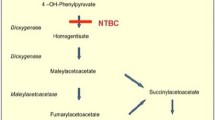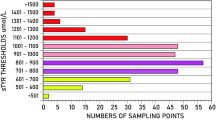Summary
Background:
Tyrosinaemia type I (TTI) is an inherited deficiency in the enzyme fumarylacetoacetate hydrolase and is frequently complicated by renal tubular dysfunction which may persist in some patients after hepatic transplantation. Nitisinone has revolutionized the management of TTI but its effect on renal tubular dysfunction has not been described in a large cohort of patients.
Aims:
To document the incidence and progression of renal tubular dysfunction in children with TTI treated with nitisinone at a single centre.
Subjects:
Twenty-one patients with TTI from a single centre were treated with nitisinone for at least 12 months. Median age at first treatment was 17 weeks (range 1 week to 27 months). Nine patients (43%) presented in acute liver failure, seven (33%) had a chronic presentation and five (24%) were detected pre-clinically.
Methods:
A retrospective case analysis of plasma phosphate, urinary protein/creatinine ratio and tubular reabsorption of phosphate was performed for all patients as markers of tubular function. Renal ultrasounds were examined for evidence of nephrocalcinosis and where available, skeletal radiographs for rickets.
Results:
All patients had biochemical evidence of renal tubular dysfunction at presentation. After nitisinone and dietary treatment were started, all three markers normalized within one year. Four children had clinical rickets at presentation (which improved), of whom one had nephrocalcinosis, which did not reverse on nitisinone. No child redeveloped tubular dysfunction after commencing nitisinone.
Summary:
All patients with TTI had evidence of tubular dysfunction at presentation and in all cases this resolved with nitisinone and dietary control.
Conclusion:
The tubulopathy associated with TTI is reversible.
Similar content being viewed by others
References
Alvares F, Bussieres J-F, Dallaire L, et al (2005) Nitisinone treatment of hepatorenal tyrosinaemia in Quebec. J Inherit Metab Dis 28(Supplement 1): 49.
Forget S, Patriquin HB, Dubois J, et al (1999) The kidney in children with tyrosinaemia: sonographic, CT and biochemical findings. Pediatr Radiol 29: 104–108.
Herzog D, Martin S, Turpin S, Alvarez F (2006) Normal glomerular filtration rate in long-term follow-up of children after orthotopic liver transplantation. Transplantation 81(5): 672–677.
Holme E, Linstedt S (2000) Nontransplant treatment of tyrosinaemia. Clin Liver Dis 4: 805–814.
Kvittingen EA, Jellum E, Stokke O, et al (1986) Liver transplantation in a 23-year-old tyrosinaemia patient: effects on the renal tubular dysfunction. J Inherit Metab Dis 9: 216–224.
Lindstedt S, Holme E, Lock EA, et al (1992) Treatment of hereditary tyrosinaemia type I by inhibition of 4-hydroxyphenylpyruvate dioxygenase. Lancet 340: 813–817.
McKiernan PJ (2006) Nitisinone in the treatment of hereditary tyrosinaemia type 1. Drugs 66: 743–750.
Mitchell G, LaRochelle J, Lambert M, et al (1990) Neurological crises in hereditary tyrosinaemia. N Engl J Med 322: 432–437.
Mitchell G, Grompe M, Lambert M, Tanguay R (2001) Hypertyrosinemia. In: Scriver CR, Beaudet AL, Sly WS, Valle D, eds; Childs B, Kinzler KW, Vogelstein B, assoc, eds. The Metabolic and Molecular Bases of Inherited Disease, 8th edn. New York: McGraw-Hill, 1777–1805.
Mohan N, McKiernan P, Preece MA, et al (1999) Indications and outcome of liver transplantation in tyrosinaemia type 1. Eur J Pediatr 158(Supplement 2): S49–54.
Paradis K, Weber A, Seidman EG, et al (1990) Liver transplantation for hereditary tyrosinemia: The Quebec experience. Am J Hum Genet 47: 338.
Pierik LJ, van Spronsen FJ, Bijleveld CM, van Dael CM (2005) Renal function in tyrosinaemia type 1 after liver transplantation: a long-term follow-up. J Inherit Metab Dis 28: 871–876.
Pronicka E, Rowinska E, Bentkowski Z, et al (1996) Treatment of two children with hereditary tyrosinaemia type I and long-standing renal disease with a 4-hydroxyphenylpyruvate dioxygenase inhibitor (NTBC). J Inherit Metab Dis 19: 234–238.
Russo P, O’Regan S (1990) Visceral pathology of hereditary tyrosinaemia type 1. Am J Hum Genet 47: 317–324.
Shoemaker LR, Strife CF, Balistreri WF, Ryckman FC (1992) Rapid improvement in the renal tubular dysfunction associated with tyrosinaemia following hepatic replacement. Pediatrics 89: 251–255.
van Spronsen FJ, Thomasse Y, Smit GP, et al (1994) Hereditary tyrosinemia type I: a new clinical classification with difference in prognosis on dietary treatment. Hepatology 20: 1187–1191.
Author information
Authors and Affiliations
Corresponding author
Additional information
Communicating editor: Jean-Marie Saudubray
Competing interests: None declared
References to electronic databases: Hereditary tyrosinaemia type I: OMIM 27670.
Rights and permissions
About this article
Cite this article
Santra, S., Preece, M.A., Hulton, SA. et al. Renal tubular function in children with tyrosinaemia type I treated with nitisinone. J Inherit Metab Dis 31, 399–402 (2008). https://doi.org/10.1007/s10545-008-0817-x
Received:
Revised:
Accepted:
Published:
Issue Date:
DOI: https://doi.org/10.1007/s10545-008-0817-x




